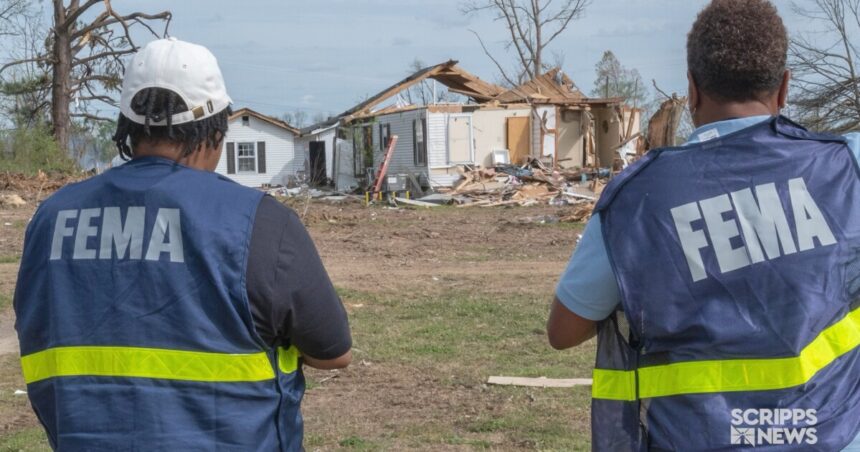Hurricane Ian plowed across the Gulf Coast of Florida in 2022, causing a record $100 billion in property damage.
After evacuating with her family, Lindsay Weishaar returned to their home in Venice, Florida, to discover water puddled on the floors from a flooded filthy creek. Black mold was already growing on soaked walls.
“It’s worse than an onion,” Weishaar said. “You start peeling a layer and there’s another layer of damage.”
Weishaar, a nurse at a local hospital, and her husband suddenly faced the staggering cost of gutting and restoring an entire house.
They would also need to pay for a temporary home for their family of four.
“Trying to find a place down here that is affordable was a nightmare,” Weishaar said. “It was expensive.”
Then there was yet another setback: Weishaar learned that neither her homeowner’s insurance nor flood insurance would cover many of the mounting costs.
So, like many Floridians recovering from the devastation of Hurricane Ian, Weishaar turned to the Federal Emergency Management Agency for help.
RELATED STORY | NOAA expects ‘extraordinary’ 2024 Atlantic hurricane season
For nearly 50 years, FEMA has provided funding to homeowners who are uninsured or underinsured to help pay for basic needs and a portion of home repairs after a major disaster. The assistance is not meant to cover the entire cost of recovery.
Up to $75,800 was available to qualified applicants after Ian.
But instead of getting funds quickly, Weishaar found herself locked in months of back and forth with FEMA, getting denial after denial as she tried to satisfy the agency’s changing requests for records necessary to prove she was eligible for funding.
“It is exhausting and mentally draining, and for the most part, not helpful at all,” Weishaar said.
A Scripps News investigation discovered that FEMA denied applications filed by hundreds of thousands of Floridians after Hurricane Ian, including from many families who qualified for assistance.
It’s a pattern of frustration with FEMA that is familiar to many homeowners recovering from other major disasters over the years, the Scripps News investigation found.
In Weishaar’s case, FEMA repeatedly rejected her requests for different reasons.
In one instance, the agency denied Weishaar and asked for proof of child care expenses. She received another denial because she needed to send itemized receipts for moving and storage costs.
Each time, Weishaar said she would upload the requested records in FEMA’s portal only to get turned down again and told to provide a new document.
“It felt like a wild goose chase every single time,” Weishaar said.
As the weeks ticked by, money became so tight that Weishaar, her husband and two daughters began living out of a camper parked in the backyard.
RELATED STORY | FEMA puts restrictions in place as disaster relief funds run low
According to a Scripps News data analysis, FEMA issued more than 261,000 denials for individual assistance after Hurricane Ian, a rejection rate of about 40%.
That figure does not include people like Miles Christian-Hart, who received far less money from FEMA than the maximum available.
Christian-Hart lives 50 miles inland in the small city of Arcadia. He has been unable to make his home livable again, almost two years after the hurricane.
“My wife and I pretty much will have exhausted our entire retirement fixing this house,” Christian-Hart said. “There’s nothing left.”
Like a growing number of people in areas prone to natural disasters, the 74-year-old pastor did not have homeowner’s insurance.
“We couldn’t get it,” he said. “Nobody would sell it to you. That’s the problem.”
Christian-Hart applied for FEMA aid, hoping for assistance to help pay some of the estimated $300,000 dollars it will take to fix his house.
He has instead received just $25,000 from FEMA, he said, only enough to remove debris from his yard.
“By the time we cleared out all of the oak trees and replaced the fencing, the money was gone,” he said.
He is still working with FEMA to obtain more aid.
RELATED STORY | Are you prepared for a natural disaster? Do these things now
A look around his neighborhood reveals many other homes are also frozen in a state of ruin, with tattered sun-bleached tarps covering roofs still in need of replacement.
FEMA was one of the few resources for families in need in Arcadia and surrounding DeSoto County, said Amanda Reuter, executive director Hope DeSoto Long Term Recovery Group.
“DeSoto County is one of the poorest communities in Florida,” Reuter said. “We just don’t have the resources here in DeSoto County to help with all of the need.”
For many homeowners, FEMA’s application process was too difficult to manage on their own, she said.
“You have to know the language,” Reuter said. “Once you learn the language, you can navigate it more easily. But that doesn’t mean they won’t change the language on you.”
Scripps News discovered FEMA has been challenging to navigate for more than two decades.
RELATED STORY | Homeowners scrambling to find insurance in natural disaster areas
An analysis of FEMA data shows that for all major disasters going back to 2002, the agency has denied roughly half of all applications for help with housing needs after a disaster.
Many applicants don’t qualify for assistance because they’re either insured, the impacted home isn’t a primary residence or there isn’t enough damage, according to FEMA data reviewed by Scripps News.
But in the case of Hurricane Ian, there are also about 8,000 denials that were successfully appealed, proving many of the rejections were for applicants who were eligible to receive aid all along.
Many qualified homeowners wrongly turned down by FEMA get caught up in the agency’s anti-fraud screening.
“We want people to get all the assistance they possibly can,” said Colt Hagmaier, assistant administrator for FEMA’s Office of Response and Recovery. “Unfortunately, we meet people every time after the disaster. We don’t know them before that. Our process for validating their identity takes a little bit of time.”
Earlier this year, FEMA announced the biggest overhaul to the individual assistance program in 20 years, promising to cut red tape, speed up the application process and expand who is eligible for aid.
“We’ve heard through many experiences talking to disaster survivors, talking to community leaders that in the past they’ve struggled with some of our programs,” Hagmaier said. “Well, we’re here to improve that.”
The changes begin this year and will not impact Hurricane Ian applicants.
Weishaar ended up receiving about $4,000 from FEMA and gave up on trying to obtain any more funds.
“It was nowhere near what people assume is the help that you are going to get, or that you’re eligible to get,” Weishaar said. “FEMA did assist people in our neighborhood. They also dropped the ball on people that truly, desperately needed their help.”
After months of living in the camper, Weishaar received a loan from the Small Business Administration and used her family’s savings to finally fix their home. They moved back into the house a year after the hurricane.
“I don’t know, honestly, that I have the mental stamina and fortitude to go through that again,” Weishaar said. “The fact that we came so close to having to make a decision of leaving our home, for good, and just selling it as-is, is terrifying.”




